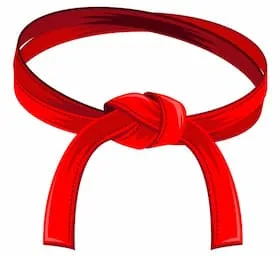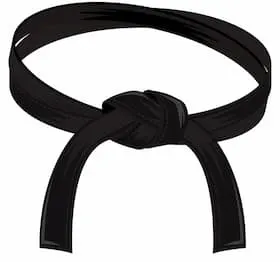
Each belt in the Taekwondo (TKD) ranking system defines the level of experience and has a certain meaning. The goal is always improving your skills and moving from one rank to the higher one. But what are the exact requirements? How does belt promotion work in Taekwondo?
Eligible taekwondo students will get an invitation to take a belt promotion test before the examiners. There are physical exercises, forms, sparring, breaking boards, and a written test as part of the promotion test. Examiners will promote you to a higher belt if you meet all the requirements.
This is just a brief explanation of how testing work in Taekwondo. Thus, be sure to read this article to learn more about it.
How does TKD belt promotion work?
Official belt promotions for geup (junior ranks) are hosted quarterly. Mostly in February, May, August, and November, though this varies depending on the governing bodies.
In general, a student will receive an invitation to participate in promotion testing from their main instructor. The invitation is usually sent well in advance of the test, giving you enough time to focus on specific tasks and prepare. Each belt rank requires different sets of techniques and skills, and you will spend most of the time enhancing these areas of your game to pass the test. Of course, the progression gets harder as a student reaches higher or more advanced ranks.
The main goal of promotion testing is to showcase progress such as improved technique, conditioning, reflexes, and an overall understanding of TKD principles. From the instructor’s point of view, the purpose of belt promotion is to signify and approve your progress and give you extra motivation to work even harder and stay on the right path.
It should be noted that the way promotion works differs between the styles of Taekwondo, countries, and even schools. Though standardized, there are certain differences when it comes to requirements for each level as well as the overall promotional criteria.
What does TKD belt testing consist of?
Physical exercises — are a part of every promotion testing, regardless of the belt. Students must showcase a high level of conditioning by performing different bodyweight exercises. This includes push-ups, squats, and sit-ups. The number of reps varies between the ranks and gets harder as you move to the higher ranks.
Forms — are also known as “poomsae” and are sets of a pre-arranged set of techniques and combos. Students perform these moves alone without a training partner. The key is to carry out specific techniques in a focused, confident manner and with perfect technique. This includes a demonstration of kicks, punches, and breaking boards. And each move is closely evaluated to the slightest detail during the process.
Sparring — is a part of testing where a student needs to demonstrate a high level of proficiency in applying techniques against a fully resisting opponent. For example, black belt testing includes three rounds of sparring against another black belt, with each round lasting 1.5–2 minutes on average. The main goal is not to win the exchange at all costs but to show a high level of skill in executing techniques against a legitimate black belt.
Written test — is usually required at the senior ranks. Students need to showcase an understanding of Taekwondo terminology, history, and philosophy.
Breaking boards — is usually the final part of testing. Depending on their age and skill level, students will break boards with their hands and kicks. Kids below nine usually break five thin boards, while advanced students above 18 years old must break a 2-inch thick board.
RECOMMENDED: Is Taekwondo Good for Kids? Parents’ Guide to Taekwondo FAQ
What are the requirements for each Taekwondo belt?
Here is a list of the technical skills that students need to learn and show to examiners in order to advance from one belt rank to the next. Remember that the exact techniques significantly differ between organizations, countries, and schools. This is a general guideline for the level of technique you can expect at each belt rank.
White belt requirements

| Stances | Blocks | Fist strikes | Kicking techniques | Strength and conditioning |
| Attention stance | Lower blocks | Front-hand middle punch | Roundhouse kick | 10 jumps |
| Ready stance | Outer block | Double punch | Front snap | 10 push-ups |
| Fighting stance | Middle block | Reverse Punch | Side kick | 10 sit-ups |
| Front stance | High block | Palm strike | Jumping front and side kicks | 10 squats |
Green belt requirements

| Stances | Blocks | Hand strikes | Kicks | Strength and conditioning |
| Back stance | Lower block | Back knuckle forward strike | Jumping front leg | 25 push-ups |
| Inner block | Lift punch | Hook kick | 25 jumps | |
| Outer block | Downward punch | Outward/Inward Crescent kick | 50 sit-ups | |
| Palm block | Hammerfist | Rear/Front foot counter kick | ||
| Pressing block | Instep turn kick | |||
| Back kick |
Blue belt requirements

| Stances | Blocks | Strikes | Kicks | Strength and conditioning |
| Rear cross stance | Trunk Push Low block | Vertical punch | Pushing front and side kick | 25 jumps |
| Cross stance | High outside block | Turning punch | Pushing kick | 25 push-ups |
| Outside wrist pressing block | Elbow rear strike | Jumping back kick | 50 sit-ups | |
| Palm Heel pressing block | Turning elbow | Jumping turn kick | ||
| Palm heel inward block | Downward elbow | Spin hook kick | ||
| Outward back fist |
Red belt requirements

| Stances | Blocks | Strikes | Kicking | Strength and conditioning |
| Tiger stance | One hand wide open block | Turn over punch | Twisting kick | 60 jumps |
| Forward cross stance | Inside wrist double block | Side Punch | Scissors kick | 60 push-ups |
| Hand blade double block | Downward and inward chop | Front foot whip kick | 100 sit-ups | |
| Palm heel block | Forward chop | Back whip kick | ||
| Scissor block | Front kick with the heel |
Black belt requirements

| Stances | Blocks | Strikes | Kicking | Strength and conditioning |
| Crane stance | Inward/outward kicking block | Extended knuckle fist | 360 degree back whip kick | 80 push-ups |
| Assisting Stance | Front/side kicking block | Fork punch | 540 degree back whip kick | 100 squats |
| Inner knee stance | Diamond block | Keumgang punch | Repeating turn/side/flip kicks | 130 doubles |
| Log Pushing Posture | Bull horn block | Palm heel forward strike | Jumping back whip kick | 10 pull-ups |
| Scissors fingertip thrust | Jumping flip kick |
How long does It take to advance through each TKD belt?
In some schools with weak criteria that promote their dojo as a place where a “black belt is secured in a short time,” you can reach a 1st-degree black belt in a year or two. However, traditional schools with good reputations stick to strict criteria; it usually takes between 3 and 5 years for a student to reach the same rank.
Following is a simple chart of how long it takes to obtain each belt in Taekwondo’s junior and senior ranks. However, keep in mind that the progression is based on individual talent, dedication, promotional criteria, and the school you train at.

RELATED: Taekwondo Belt Ranking System – EASILY Explained For Beginners
What happens when you fail the Taekwondo promotion test?
Failing a Taekwondo test is not the end of the world and is considered a part of the learning process. If you fail, your main instructor and examiners will explain to you the reason you failed. Then, they would say what you could have done better and advise which areas you need to work on to improve, come back, and pass the test.
Also, you don’t need to wait long before you can attend the testing again. When it comes to the junior ranks (geups), testing is organized quarterly. This gives you enough time to improve, come back, and pass the test.
Remember that seeing a student fail a promotion test is uncommon. By the time they step on the mats to perform, most students have already mastered the required techniques and skills. If they didn’t, they wouldn’t receive an invite from their main instructor after all. The instructor would extend the time before you can be graded and give you more time to improve your form before you are deemed ready for a higher belt.
The main reason TKD students fail a test is not a lack of skill. Some students actually get overwhelmed by the pressure of the moment and get too anxious. This may lead to some mistakes during the demonstration.
Can you get double-promoted in TKD if you are really good?
Taekwondo students can “skip” a level and get double promoted if they show the required skill level, but this rarely happens. In most cases, students who get double promoted already have previous experience in a conceptually similar martial art, such as karate.
Those who get double promoted because of their athleticism and ability to adopt knowledge and progress are way ahead of other students in their group. Once the main instructor spots you progressing faster, they will consider inviting you to a double promotion test.
However, most schools prefer to stick to the standardized learning curriculum without making these types of exceptions. This is notably true for schools that embrace traditional methods of teaching and ranking. According to their philosophy, developing skills and adopting the philosophy of Taekwondo must be done steadily, and you have to enjoy the process.
Is there a fee for TKD promotion?
Students are required to pay a fee whenever they are attending promotional testing. Of course, the exact price varies between the organizations, and the economic standard is not the same in all countries. For the purpose of this article, let’s focus on the Taekwondo testing fees in the US.
If you are applying for a color belt test (geups), the fee ranges between $30 and $100 in some states and schools. In some cases, the main instructor takes the entire fee for their time. But in other cases, a large portion of it is actually sent to the association that organizes the testing. However, the instructor provides the certificate and color belt you receive, not the association.
The price of Taekwondo black belt exams (dan ranks) is significantly higher. For example, a student has to pay between $150 and $500 for the 1st-degree black belt test in all three major TKD styles, ATA, ITF, and WT. The price includes a color belt, a certificate, and, in some rare cases, a brand new uniform. The testing price progressively goes up as you move through the other nine black belt ranks.
The prices in other countries and the way the fee system works differ greatly, and it is almost impossible to come up with close numbers. For example, the fees are much lower in some economically undeveloped countries. Also, schools with a long history and good reputations tend to charge more than the new ones, and many other variables determine the price.
Do you have to compete in a tournament to get promoted?
Most Taekwondo schools, notably traditional ones, rely solely on the skill you demonstrated in testing when it comes to belt promotion. Being a solid competitor and continuously winning matches in competition further confirms your skill level. But the results themselves do not make your life easier in testing for a higher belt.
However, some other styles, like World Taekwondo (WT), for example, rely heavily on the competition. The entire learning curriculum is designed to align with the competition’s official rules. Hence, the belt progression is centered around the competition. WT instructors often rely on your results in matches as a benchmark for your level of proficiency. But even in these styles, competing in a tournament is not a requirement for a higher rank.
RELATED: Olympic TKD vs. Traditional TKD – Key Differences Explained
What is the difference between TKD promotion and BJJ promotion?
Both of these martial arts include belt promotions, but the way students get promoted differs a lot because there is no belt testing in BJJ.
Brazilian Jiu-Jitsu has a similar ranking system, but no official belt testing is organized by the BJJ association or other governing body. There is no board of examiners in front of which you need to perform.
Instead, BJJ students get promoted by their main instructor. It is entirely up to the main instructor and their subjective opinion to decide whether a student has reached a certain level of proficiency required for the higher rank. This also means that students can be promoted at any time, which often catches them by surprise.
Taekwondo differs in every way because, in order to move from one rank to the next, students need to attend official belt testing. Depending on the rank, testing is organized a couple of times a year, usually quarterly. They need to perform in front of the board of examiners, including their main instructor, and showcase the required level of proficiency. Once they pass, they will receive an official certificate and a new rank belt.
